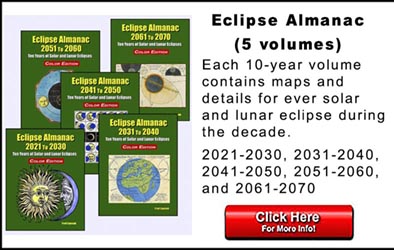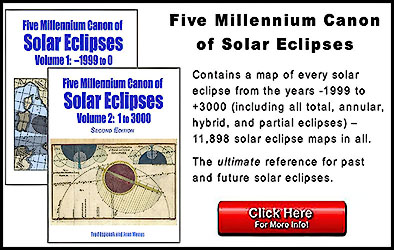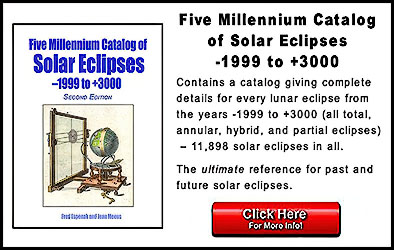Eclipses During 2022
By Fred Espenak
Based on the Article Published in
Observer's Handbook 2022,
Royal Astronomical Society of Canada
In 2022, there are two solar eclipses and two lunar eclipses:
| Eclipses During 2022 | |||
| 2022 Apr 30: Partial Solar Eclipse | |||
| 2022 May 16: Total Lunar Eclipse | |||
| 2022 Oct 25: Partial Solar Eclipse | |||
| 2022 Nov 08: Total Lunar Eclipse | |||
| Eclipses During 2022 | |||
|
Partial Solar Eclipse 2022 Apr 30 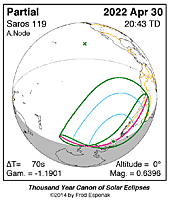
|
Total Lunar Eclipse 2022 May 16 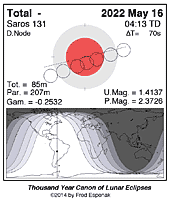
|
Partial Solar Eclipse 2022 Oct 25 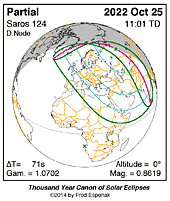
|
Total Lunar Eclipse 2022 Nov 08 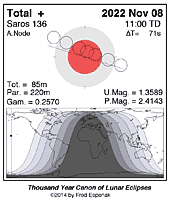
|
Predictions for the eclipses are summarized in Tables 1 through 4. World maps show the regions of visibility for each eclipse. The lunar eclipse diagrams also include the path of the Moon through Earth’s shadow. Contact times for each principal phase are tabulated along with the magnitudes and geocentric coordinates of the Sun and the Moon at greatest eclipse.
Unless otherwise stated, all times and dates used in this publication are in Universal Time or UT1 [1]. This astronomically derived time system is colloquially referred to as Greenwich Mean Time or GMT. To learn more about UT1 and how to convert UT1 to your own local time, see Time Zones and Universal Time.
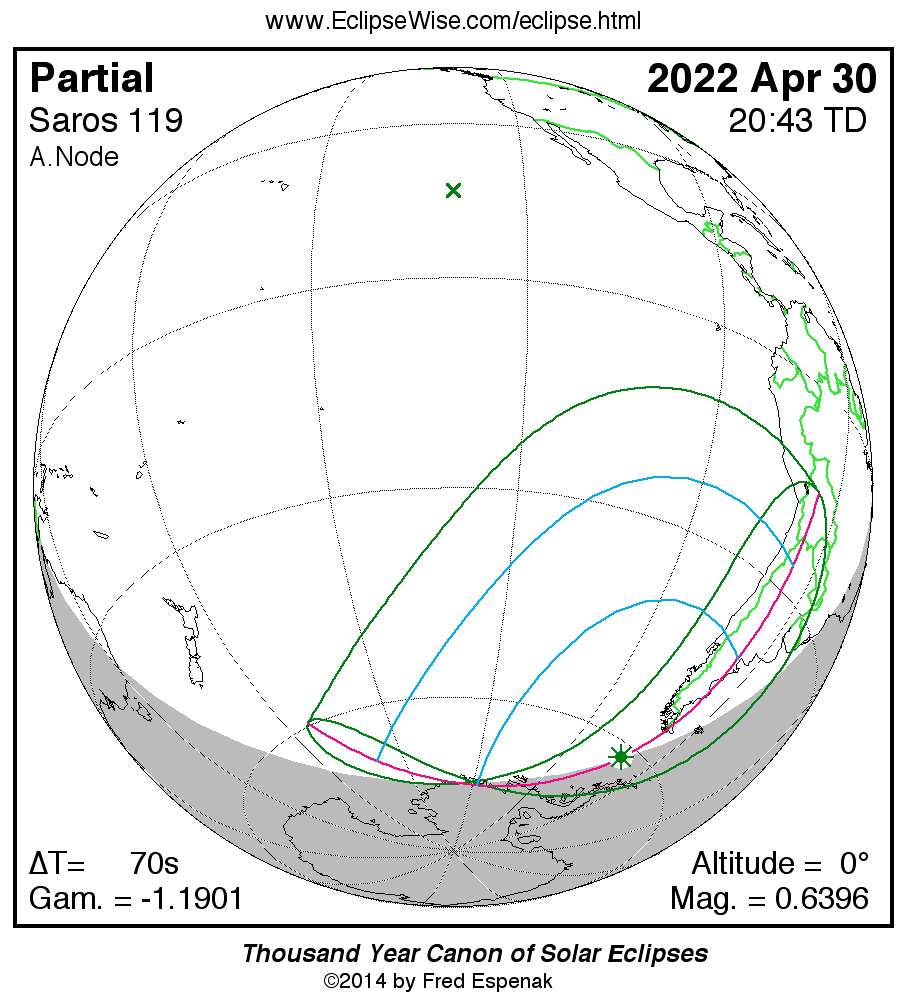
Click for larger more detailed figure
Partial Solar Eclipse of 2022 Apr 30
The first solar eclipse of 2022 is a Southern Hemisphere event visible from South America and the South Pacific (Figure 1). Greatest eclipse [2] takes place at 20:41:26 UT1 when the eclipse magnitude [3] reaches 0.6396. The contact times of the Moon’s penumbral shadow with Earth are as follows:
Partial eclipse begins: 18:45:19 UT1
Partial eclipse ends: 22:38:01 UT1
Local circumstances for a number of cities are given in Table 1. All times are provided in Local Time. The Sun’s altitude and azimuth, the eclipse magnitude, and obscuration [4] are all listed for the instant of maximum eclipse.
The 2022 April 30 Solar Eclipse Circumstances Calculator is an interactive web page that can quickly calculate the local circumstances for the eclipse from any geographic location not included in the table.
The path of the eclipse is plotted on an interactive map at Google Map of the 2022 Apr 30 Solar Eclipse . This map permits zooming and scrolling as desired. Clicking the cursor on any location calculates the eclipse circumstances for that location. For more information see Key to Google Eclipse Maps.
This is the 66th eclipse of Saros [6] series 119, an old series, which produced its last central eclipse (annular) on 1950 Mar. 18. The entire series is composed of 71 solar eclipses in the following sequence: 8 partial, 2 total, 1 hybrid, 51 annular, and 9 partial eclipses (Espenak and Meeus, 2021a). Saros series 119 runs from the years 850 to 2112.
Complete details for the 71 eclipses in the series may be found at Saros 119.
For more information about this eclipse, see the EclipseWise Prime Page at Partial Solar Eclipse of 2022 April 30.
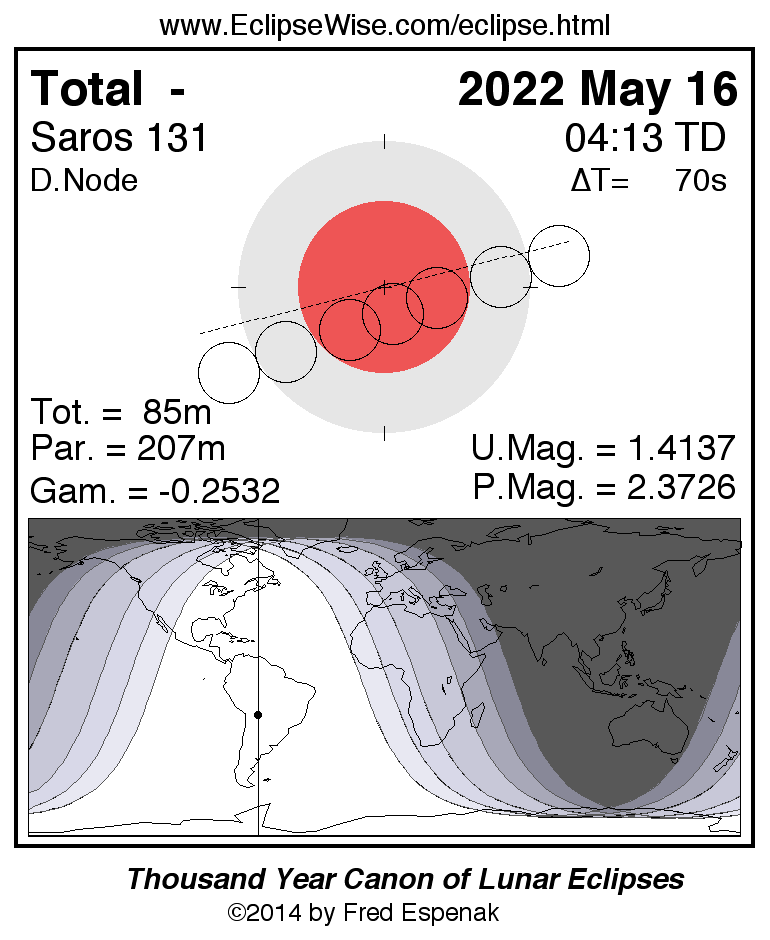
Click for larger more detailed figure
Total Lunar Eclipse of 2022 May 16
The second eclipse of the year is a total lunar eclipse occurring at the lunar orbit's descending node in Libra. It occurs 1.5 days before perigee (May 17 19:23 UT1). Consequently, the apparent diameter of the Moon (33.0 arc-minutes) is much larger than its mean diameter (31.1 arc-minutes). This is perigean Full Moon will likely be hyped by the media as a so-called Blood Supermoon.
The Moon's orbital trajectory takes it through the southern part of Earth’s dark umbral shadow. The times of the major eclipse phases are as follows.
Penumbral Eclipse Begins: 01:31:44 UT1
Partial Eclipse Begins: 02:27:31 UT1
Total Eclipse Begins: 03:28:40 UT1
Greatest Eclipse: 04:11:31 UT1
Total Eclipse Ends: 04:54:11 UT1
Partial Eclipse Ends: 05:55:27 UT1
Penumbral Eclipse Ends: 06:51:11 UT1
The beginning and end of a penumbral eclipse are not visible to the eye. In fact, no shading can be detected until about 2/3 of the Moon's disk is immersed in the penumbra. This would correspond to about 02:10 UT1 when the penumbral eclipse is first detectable. Keep in mind that this is only an estimate. Atmospheric conditions and the observer's visual acuity are important factors to consider. An interesting exercise is to note when penumbral shading is first and last detected with the naked eye or binoculars.
At the instant of greatest eclipse [7] (04:11:31 UT1), the Moon lies at the zenith for a point near the border between Bolivia and Paraguay. The umbral eclipse magnitude [8] peaks at 1.4154. At this time, the Moon’s northern limb passes 1.2 arc-minutes south of the shadow’s axis. In contrast, the Moon’s southern limb will lie 31.8 arc-minutes from the shadow center and 13.9 arc-minutes from the southern edge of the umbra. Consequently, the southern half of the Moon will appear considerably brighter than the northern half, which will lie deeper in the shadow.
Since the Moon samples a large range of umbral depths during totality, its appearance will likely change dramatically with time. The exact brightness distribution in the umbra is difficult to predict, so observers are encouraged to estimate the Danjon value at mid-totality (see Danjon Scale of Lunar Eclipse Brightness). It may also be necessary to assign different Danjon values to different portions of the Moon (e.g., north vs. south).
Nearly 40 years ago (1982 July 06), the author watched another total lunar eclipse with the Moon in nearly the same part of the sky. I was amazed at how brilliantly the summer Milky Way glowed since it was all but invisible during the partial phases. Observers will have a similar opportunity during May's eclipse. In this case, the totally eclipsed Moon will lie in eastern Libra 30° west of the brightest Sagittarian star clouds. The summer constellations are well placed for viewing so a number of bright stars can be used for magnitude comparisons with the totally eclipsed Moon.
Antares (mv = +0.92v) is 15° to the southeast, Shaula (mv = +1.63) is 31° southeast, Epsilon Sgr (mv = +1.85) is 40° southeast, Arcturus (mv = -0.05) stands 43° to the northwest, and Spica (mv = +0.97) is 32° northwest of the Moon. The Moon’s brightness during totality can be easily estimated using a pair of binoculars (see Moon's Apparent Magnitude During Total Lunar Eclipses).
The entire event is visible from the Western Hemisphere (eastern Pacific Ocean, most of North and South America). Europe will miss the later stages of the eclipse because they occur after moonset. None of the eclipse is visible from Asia or Australia (seen visibility map in Figure 2).
Table 2 lists predicted umbral immersion and emersion times for 25 well-defined lunar craters. The timing of craters is useful in determining the atmospheric enlargement of Earth's shadow (see Crater Timings During Lunar Eclipses).
The May 16 eclipse is the 34th eclipse of Saros series 131. The series is composed of 72 lunar eclipses in the following sequence: 7 penumbral, 22 partial, 15 total, 20 partial, and 8 penumbral eclipses (Espenak and Meeus, 2021b). Saros 131 spans 1280.1 years and runs from the years 1427 to 2707.
Complete details for Saros 131 (including all eclipses in the series) can be found at: Saros 131.
For more information about this eclipse, see the EclipseWise Prime Page at Total Lunar Eclipse of 2022 May 16.
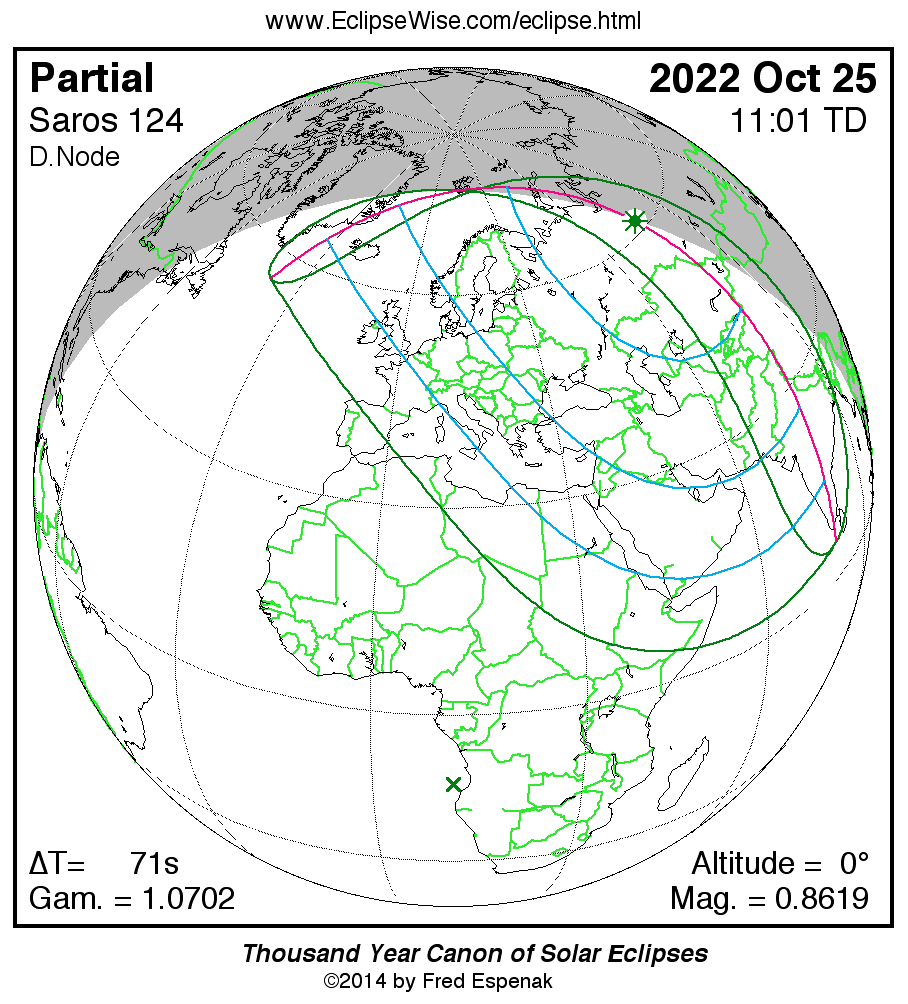
Click for larger more detailed figure
Partial Solar Eclipse of 2022 Oct 25
The second solar eclipse of 2022 is visible from the Northern Hemisphere. Most of Europe, the Middle East, Central Asia and northeastern Africa will be in the path of the Moon’s penumbral shadow (Figure 3).
Greatest eclipse takes place at 11:00:09 UT1 when the eclipse magnitude will reach 0.8619. The contact times of the Moon’s penumbral shadow with Earth are as follows:
Partial eclipse begins: 08:58:20 UT1
Partial eclipse ends: 13:02:16 UT1
Local circumstances for a number of cities are given in Table 3. All times are provided in Local Time. The Sun’s altitude and azimuth, the eclipse magnitude, and obscuration are all listed for the instant of maximum eclipse.
The 2022 October 25 Solar Eclipse Circumstances Calculator is an interactive web page that can quickly calculate the local circumstances for the eclipse from any geographic location not included in the table.
The path of the eclipse is plotted on an interactive map at Google Map of the 2022 Oct 25 Solar Eclipse . This map permits zooming and scrolling as desired. Clicking the cursor on any location calculates the eclipse circumstances for that location. For more information see Key to Google Eclipse Maps.
This is the 55th eclipse of Saros series 124, another old series that produced its last central eclipse on 1986 Oct 3. That event was an unusual beaded annular eclipse with a very short path just off the west coast of Iceland. The entire series is composed of 73 solar eclipses in the following sequence: 9 partial, 43 total, 1 annular, and 20 partial eclipses (Espenak and Meeus, 2021a). Saros 124 lasts 1298 years running from 1049 to 2347.
Complete details for the 73 eclipses in the series may be found at Saros 124.
For more information about this eclipse, see the EclipseWise Prime Page at Partial Solar Eclipse of 2022 October 25.
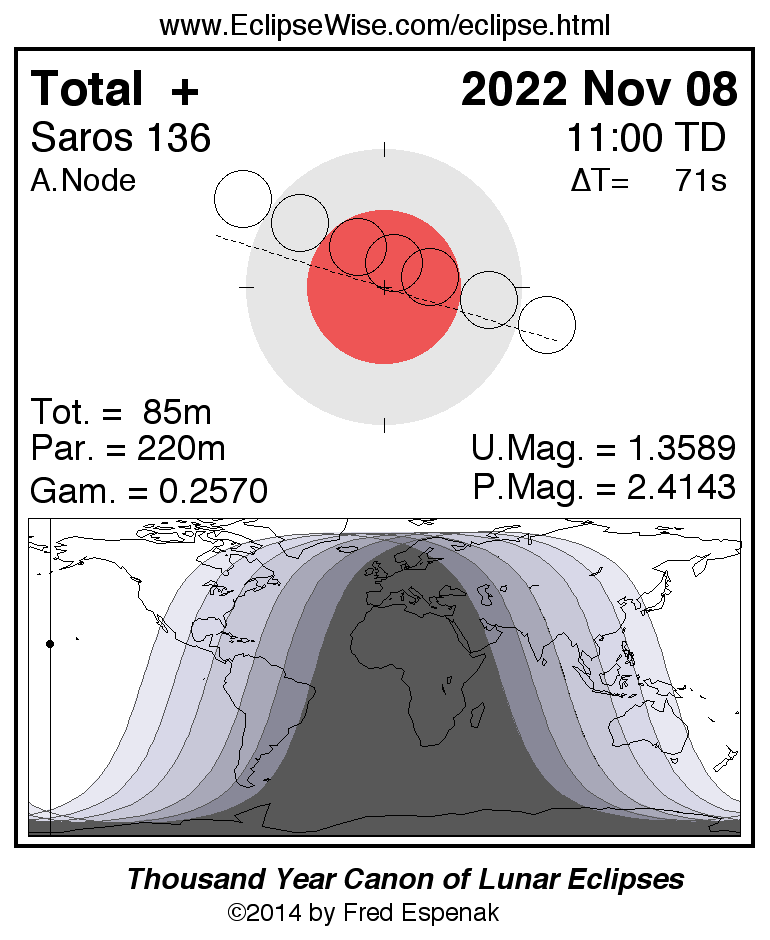
Click for larger more detailed figure
Total Lunar Eclipse of 2022 Nov 08
The last eclipse of the year is another total lunar eclipse. Once again, the event will be well placed for North Americans. The eclipse occurs at the ascending node of Luna’s orbit in southern Aries. Since the Moon is 5.8 days shy of apogee (Nov 14 10:41 UT1), it will appear 7% smaller (30.6 arc-minutes) than it was during May’s eclipse. The Moon’s trajectory takes it deep into the northern umbral shadow, resulting in a total eclipse that lasts ~86 minutes, and with an umbral eclipse magnitude of 1.3607.
The Moon’s path through Earth’s shadow and a map illustrating worldwide visibility of the event are shown in Figure 4. The times of the major eclipse phases are listed as follows.
Penumbral Eclipse Begins: 08:01:52 UT1
Partial Eclipse Begins: 09:08:49 UT1
Total Eclipse Begins: 10:16:12 UT1
Greatest Eclipse: 10:59:11 UT1
Total Eclipse Ends: 11:41:52 UT1
Partial Eclipse Ends: 12:49:24 UT1
Penumbral Eclipse Ends: 13:56:32 UT1
At mid-eclipse the Moon’s southern limb is just 0.9 arc-minutes from the umbra’s center. In contrast, the northern limb is 11.0 arc-minutes from the umbra’s edge and 29.7 arc-minutes from its center. Since different parts of the Moon will probe radically different portions of Earth’s umbral shadow, a large variation in shadow brightness can be expected. The northern half of the totally eclipsed Moon will appear noticeably brighter than its southern half. Observers are encouraged to estimate the Danjon value at mid-totality (see Danjon Scale of Lunar Eclipse Brightness).
The instant of greatest eclipse (10:59:11 UT1) occurs with the Moon in the zenith for a point in the Pacific Ocean west of the Hawaiian Islands. Most of North America will be treated to the entire eclipse. However, the partial phases will still be in progress at moonset for observers in the eastern United States and Canada. Most of Australia will see the beginning of totality just after moonrise, but observers in the western quarter of the country will see the Moon already in total eclipse when it rises.
During totality, the winter constellations are well placed for viewing so a number of bright stars can be used for magnitude comparisons. Aldebaran (mv = +0.75 > +0.95) is 25° east of the eclipsed Moon, Hamal (mv = +2.00) is 12° to the northwest, Capella (mv = +0.08) is 42° to the northeast, while Betelgeuse (mv = ~ +0.60) and Rigel (mv = +0.13) are 46° and 43°, respectively, to the east-southeast.
The Moon’s brightness during totality can be easily estimated using these stars and a pair of binoculars (see Moon's Apparent Magnitude During Total Lunar Eclipses). Table 4 lists predicted umbral immersion and emersion times for 25 well-defined lunar craters. The timing of craters is useful in determining the atmospheric enlargement of Earth's shadow (see Crater Timings During Lunar Eclipses).
The Nov 08 eclipse is the 20th eclipse of Saros 136. This series is composed of 72 lunar eclipses in the following sequence: 8 penumbral, 7 partial, 27 total, 8 partial, and 22 penumbral eclipses (Espenak and Meeus, 2021b). Saros 136 spans 1280.1 years and runs from 1680 Apr 13 to 2960 Jun 01.
Complete details for Saros 136 (including all eclipses in the series) can be found at: Saros 136.
For more information about this eclipse, see the EclipseWise Prime Page at Total Lunar Eclipse of 2022 November 08.
Explanatory Information
Solar Eclipse Figures
Lunar Eclipse Figures
Enlargement of Earth's Shadows and Lunar Eclipses
Danjon Scale of Lunar Eclipse Brightness
Moon's Apparent Magnitude During Total Lunar Eclipses
Crater Timings During Lunar Eclipses
Eclipse Altitudes and Azimuths
The altitude a and azimuth A of the Sun or Moon during an eclipse depend on the time and the observer's geographic coordinates. They are calculated as follows:
h = 15 (GST + UT - α ) + λ
a = arcsin [sin δ sin φ + cos δ cos h cos φ]
A = arctan [-(cos δ sin h)/(sin δ cos φ - cos δ cos h sin φ)]
where
h = hour angle of Sun or Moon
a = altitude
A = azimuth
GST = Greenwich Sidereal Time at 0:00 UT
UT = Universal Time
α = right ascension of Sun or Moon
δ = declination of Sun or Moon
λ = observer's longitude (east +, west -)
φ = observer's latitude (north +, south -)
During the eclipses of 2022, the values for GST and the geocentric Right Ascension and Declination of the Sun or the Moon (at greatest eclipse) are as follows:
Eclipse Date GST α δ
Partial Solar 2022 Apr 30 14.585 2.538 14.965
Total Lunar 2022 May 16 15.591 15.524 -19.328
Partial Solar 2022 Oct 25 2.255 13.989 -12.171
Total Lunar 2022 Nov 08 3.174 2.897 16.852
Two web based tools that can also be used to calculate the local circumstances for all solar and lunar eclipses visible from any location. They are the Javascript Solar Eclipse Explorer and the Javascript Lunar Eclipse Explorer. The URLs for these tools are:
Javascript Solar Eclipse Explorer: www.EclipseWise.com/solar/JSEX/JSEX-index.html
Javascript Lunar Eclipse Explorer: www.EclipseWise.com/lunar/JLEX/JLEX-index.html
Eclipses During 2023
In 2023, there are two solar eclipses and two lunar eclipses:
| 2023 Apr 20: Hybrid Solar Eclipse |
| 2023 May 05: Penumbral Lunar Eclipse |
| 2023 Oct 14: Annular Solar Eclipse |
| 2023 Oct 28: Partial Lunar Eclipse |
| Eclipses During 2023 | |||
|
Hybrid Solar Eclipse 2023 Apr 20 
|
Penumbral Lunar Eclipse 2023 May 05 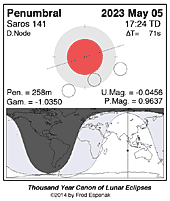
|
Annular Solar Eclipse 2023 Oct 14 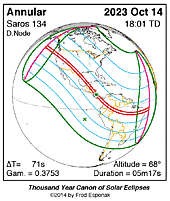
|
Partial Lunar Eclipse 2023 Oct 28 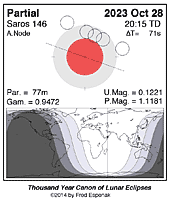
|
A full report Eclipses During 2023 will be published in Observer's Handbook: 2023.
Eclipse Web Sites
EclipseWise.com is a website dedicated to predictions and information on eclipses of the Sun and Moon. It offers a graphically intuitive interface and contains maps, diagrams, tables, and information about every solar and lunar eclipse from 2000 BCE to 3000 CE. This period includes 11898 solar eclipses and 12064 lunar eclipses.
Much of EclipseWise.com is based on the Thousand Year Canon of Solar Eclipses 1501 to 2500 (Espenak 2014a) and the Thousand Year Canon of Lunar Eclipses 1501 to 2500 (Espenak 2014b). These eclipse predictions use the Jet Propulsion Lab's DE406 — a computer ephemeris used for calculating high precision coordinates of the Sun and Moon for thousands of years into the past and future.
For eclipses over a larger time interval see Five Millennium Canon of Solar Eclipses –1999 to +3000 and Five Millennium Canon of Lunar Eclipses –-1999 to +3000.
The World Atlas of Solar Eclipses provides maps of all central eclipse paths from 2000 BCE to 3000 CE.
MrEclipse.com targets solar and lunar eclipse photography, with tips on eclipse observing and eye safety.
For web versions of this article for other years, visit the following:Acknowledgments
All eclipse predictions were generated on a Macintosh G4 PowerPC using algorithms developed from the Explanatory Supplement [1974] with additional algorithms from Meeus, Grosjean, and Vanderleen [1966]. The solar and lunar coordinates used in the eclipse predictions are based on the JPL DE405. For lunar eclipses, the elliptical shape of the umbral and penumbral shadows were calculated using Herald and Sinnott (2014) method of enlarging Earth's radius to compensate for the opacity of the terrestrial atmosphere (including corrections for the oblateness of Earth).
All calculations, diagrams, tables, and opinions presented in this paper are those of the author, and he assumes full responsibility for their accuracy.
Permission is granted to reproduce the eclipse data when accompanied by a link to this page and an acknowledgment:
"Eclipse Predictions by Fred Espenak, EclipseWise.com"
The use of diagrams and maps is permitted provided that they are unaltered (except for re-sizing) and the embedded credit line is not removed or covered.
Footnotes
[1] UT1 or Universal Time is the mean solar time on the Prime Meridian at Greenwich, England. Civil time signals are transmitted according to Coordinated Universal Time (UTC), which is based on International Atomic Time (TAI) with leap seconds added at irregular intervals to compensate for the slowing of Earth's rotation. The leap seconds keep UTC within 0.9 second of UT1.
[2] The instant of greatest eclipse for solar eclipses occurs when the distance between the Moon's shadow axis and Earth's geocenter reaches a minimum.
[3] Eclipse magnitude for solar eclipses is defined as the fraction of the Sun's diameter occulted by the Moon.
[4] Eclipse obscuration is defined as the fraction of the Sun's area occulted by the Moon.
[5] For solar eclipses, gamma is the distance of the Moon's shadow axis from Earth's center (in Earth radii) when it reaches its minimum absolute value.
[6] The Saros is a period of 6,585.3 days (18 years 11 days 8 hours) in which eclipses (both solar and lunar) repeat. The geometry isn't exact but close enough for a Saros series to last 12 or more centuries.
[7] The instant of greatest eclipse for lunar eclipses occurs when the distance between the Moon and Earth's shadow axis reaches a minimum.
[8] Umbral eclipse magnitude is defined as the fraction of the Moon's diameter occulted by Earth's umbral shadow.
[9] For lunar eclipses, gamma is the distance of the Moon's center from Earth's shadow axis (in Earth radii) when it reaches its minimum absolute value.
[10] Penumbral eclipse magnitude is defined as the fraction of the Moon's diameter occulted by Earth's penumbral shadow.
References
Chauvenet, W., Manual of Spherical and Practical Astronomy, Vol.1, 1891 (Dover edition 1961).
Danjon, A., "Les éclipses de Lune par la pénombre en 1951," L'Astronomie, 65, 51-53 (Feb. 1951).
Espenak, F., Meeus, J., Five Millennium Canon of Solar Eclipses –1999 to +3000, 2nd Edition, AstroPixels Publishing, Portal, AZ, 2021.
Espenak, F., Meeus, J., Five Millennium Canon of Lunar Eclipses –-1999 to +3000, 2nd Edition, AstroPixels Publishing, Portal, AZ, 2021.
Espenak, F., Thousand Year Canon of Solar Eclipses 1501 to 2500, AstroPixels Publishing, Portal, AZ, 2014.
Espenak, F., Thousand Year Canon of Lunar Eclipses 1501 to 2500, AstroPixels Publishing, Portal, AZ, 2014.
Espenak, F., 21st Century Canon of Solar Eclipses, AstroPixels Publishing, Portal, AZ, 2016.
Espenak, F., 21st Century Canon of Lunar Eclipses, AstroPixels Publishing, Portal, AZ, 2020.
Espenak, F., Atlas of Central Solar Eclipses in the USA, AstroPixels Publishing, Portal, AZ, 2016.
Explanatory Supplement to the Astronomical Ephemeris and the American Ephemeris and Nautical Almanac, Her Majesty's Nautical Almanac Office, London, 1974.
Herald, D., and Sinnott, R. W., “Analysis of Lunar Crater Timings, 1842–2011,” J. Br. Astron. Assoc., 124, 5, 2014.
Keen, R. A., "Volcanic Aerosols and Lunar Eclipses", Science, vol. 222, p. 1011-1013, Dec. 2, 1983.
Meeus, J., Elements of Solar Eclipses 1951-2200, Willmann-Bell, Richmond, VA (1989).



